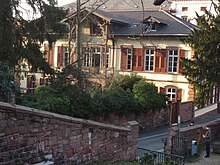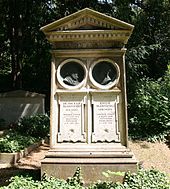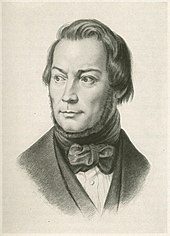Johann Caspar Bluntschli
Johann Caspar Bluntschli , also Johann Kaspar Bluntschli (born March 7, 1808 in Zurich , † October 21, 1881 in Karlsruhe ) was a Swiss legal scholar and politician from Baden . Bluntschli taught at the universities of Zurich , Munich and Heidelberg . Bluntschli was a member of the Heidelberg Lodge Ruprecht zu den five Rosen .
Life


Coming from a long-established Zurich family - his father was a candle and soap manufacturer - Bluntschli first studied law in his hometown at the Political Institute. In order to deepen his historical, philosophical and legal education, he studied in Berlin and Bonn from 1827 to 1829, where he was awarded a doctorate in 1829 with a dissertation on the Roman right to inheritance. jur. received his doctorate. After a stay in Paris , which gave Bluntschli an insight into French judicial practice, he returned to Zurich in April 1830 to initially become a trainee lawyer at the Zurich District Court and later Secretary of the Government Commission for the Interior. In the political turmoil of the Restoration period , Bluntschli confessed to the liberal-conservative movement, for which he wrote a program in 1832.
Bluntschli taught at the University of Zurich from 1833 (where he was rector from 1844/45 ), from 1848 at the University of Munich and from 1861 at the University of Heidelberg. In 1873 he was one of the founders of the Institut de Droit international in Ghent . He was president of the 2nd (1861 in Dresden) and the 8th (1869 in Heidelberg) German Lawyers' Conference . Bluntschli was president of the German Protestant Association .
In 1840 Bluntschli was commissioned to draw up the Zurich private law code , which came into force from 1854–1856 and was observed throughout the world. Further works are General State Law (1852), in addition he wrote a. a. a German state dictionary in eleven volumes (1857–1870, together with Karl Brater ) and Modern Martial Law of the Civilized States (1866), which influenced the deliberations on the Hague Land Warfare Regulations . His book on the right to author (1853) also gained importance , in which he established the right of the author to decide on the publication of his work on the basis of natural law . Bluntschli's explanation of the legal character of international law differed from most of his contemporaries because, in turning away from Friedrich Carl von Savigny's theories, he sought to overcome the contradiction between natural law and positive law.
In 1864 Bluntschli became a Freemason and member of the Ruprecht zu den five Rosen Lodge in Heidelberg , where he shaped the Lodge through his work as Master of the Chair . In 1865 he wrote to Pope Pius IX on behalf of his lodge . an open letter in response to his apostolic letter Multiplices inter , in which Freemasonry was condemned again. This open letter caused a sensation. From 1872 to 1878 he was the grand master of the Grand Lodge "Zur Sonne" in Bayreuth and contributed to its constitution and its rituals. On the grand lodge days he advocated the unity of the German Freemasons under a single German grand lodge. A specific draft that he presented at the Grand Lodge in 1878, however, met with little approval, which hit him hard. He was often in Freiburg, the Zur noble Aussicht lodge there also belonged to the grand lodge "Zur Sonne", and countered the allegations Alban Stolz.

From 1861 to 1868 Bluntschli was a member of the First Chamber of the Baden Estates Assembly , appointed by the Grand Duke . From 1869 to 1870 and again from 1879 to 1880 he held a mandate in the same First Chamber as a representative of Heidelberg University. In 1868 he was elected as a member of the German customs parliament for the Baden constituency of Bretten - Sinsheim . From 1873 to 1876 Bluntschli was a member of the 14th electoral district (Villingen) in the Second Chamber of the Baden Estates Assembly. There he was in the faction of the National Liberal Party . In 1879 he belonged together with the Kommerzienrat Friedrich Engelhorn ( BASF ), the secret Kommerzienrat Carl Eckhard, Dr. Gustav Herdt, the consul general of the Netherlands Simon Hartogensis and Karl Funck among the founders of Mannheimer Versicherung . In 1868 Bluntschli was elected to the American Academy of Arts and Sciences .
Under the influence of Gobineau's writings and the contemporary Aryan myth , Bluntschli openly advocated racist theories. He assumed a hierarchical racial order and a close connection between “race” and the nation state, with the “Aryan-Geman” states of the day standing out (especially the German Reich) and the “black race”, in his opinion, incapable of legal perception and state formation .
Johann Caspar Bluntschli was married to Emilie Vogel on February 27, 1831. Her son Alfred Friedrich Bluntschli , a successful architect, was first a pupil and later succeeded Semper as a professor at the Zurich Building School . Bluntschli's autobiography , published in 1884, is entitled Memorable From My Life .
Bluntschli died on October 21, 1881 in Karlsruhe; his successor as professor at the University of Heidelberg in 1882 was the Baltic German lawyer August von Bulmerincq . Bluntschli was buried in the family grave of the Heidelberg mountain cemetery, where he rests next to his wife Emilie, who died in 1876. The tombstone is adorned with two finely worked bronze portrait medallions depicting the couple. The grave is on the so-called "Professorenweg" in Department D. In 1896 a street in Heidelberg was named after Bluntschli.
Fonts
- Development of succession against the will according to Roman law . Bonn 1829.
- The party of the moderate in their being and wanting . Zurich 1832.
- State and legal history of the city and landscape of Zurich , volume 1: Die Zeit des Mittelalter , Zurich 1838, volume 2: Die neue Zeit , Zurich 1839. - 2nd, [edited] edition Zurich 1856.
- The communists in Switzerland according to the papers found at Weitling's . Zurich 1843; Reprint: Hildesheim, Gerstenberg, 1972, ISBN 3-8067-0154-7 (so-called “Bluntschli report” ).
- Uri, Schwyz and Unterwalden and their first everlasting leagues . Zurich 1846.
- History of the Republic of Zurich . Volume 1 , Volume 2 , Zurich 1847.
- History of Swiss federal law from the first eternal leagues to the present day. Volume 1: Historical representation . Zurich 1849; Volume 2: Document book . Zurich 1852.
- General constitutional law . Munich 1852. Third revised edition . Munich 1863.
- The so-called font ownership. The author right. Critical review of German legislation and jurisprudence. Munich 1853.
- German State Dictionary (Ed.), 12 vols. Stuttgart / Leipzig 1857–1870 [together with Karl Brater].
- History of the right to freedom of religion . Elberfeld 1867.
- The founding of the American Union in 1787 . Berlin 1868.
- The modern international law of the civilized states presented as a legal book . Nördlingen 1869 ( digitized version and full text in the German text archive )
- German legal proverbs . Nordlingen 1869.
- Character and spirit of political parties . Noerdlingen, 1869.
- Bluntschli's state dictionary in three volumes. Based on the German state dictionary by Bluntschli u. Brater in 11 volumes, in association with several scholars; [together with] Nachtr. Schulthess, Zurich 1872 ( digitized version ).
- General political theory . Fifth revised edition of the first volume of the general constitution. Stuttgart, 1875 ( digitized and full text in the German text archive )
- The prize law in the war and the right of capture in particular . Nordlingen 1878.
- The organization of the European association of states . In: Die Gegenwart 1878, No. 6, pp. 81-84, No. 8, pp. 114-116 and No. 9, pp. 131-133. Again in: Collected Small Writings . Vol. 2, Noerdlingen 1881, pp. 279-312.
- The liability of the state from illegal acts of its officials under German private and state law . Frankfurt a. M., 1879.
- History of modern political science . Munich 1881.
- Memorable things from my life . 3 vols. Nördlingen 1884,
Bluntschli's estate is located in the Zurich Central Library and the Johns Hopkins University in Baltimore (USA).
literature
- Alban Stolz : The fear of witches in the enlightened world. Unsealed letter to Mr. Bluntschli and brothers. Freiburg im Breisgau 1871 (counter-writ).
- Hugo Ficke: History of the Masonic Lodge for the noble view in Freiburg in Baden. Freiburg im Breisgau 1874 ( http://dl.ub.uni-freiburg.de/diglit/ficke1874/0001/thumbs?sid=0ee9381e78458ef9532ad03530dfa7e4 ).
- Gerold Meyer von Knonau : Bluntschli, Johann Caspar . In: Allgemeine Deutsche Biographie (ADB). Volume 47, Duncker & Humblot, Leipzig 1903, pp. 29-39.
- Heinrich Mitteis: Bluntschli, Johann Caspar. In: New German Biography (NDB). Volume 2, Duncker & Humblot, Berlin 1955, ISBN 3-428-00183-4 , p. 337 f. ( Digitized version ).
- Jacques Vontobel: Johann Caspar Bluntschlis doctrine of law and state. Schulthess, Zurich 1956, OCLC 264959126 Dissertation University of Zurich 1956 under the title: The liberal-conservative, organic legal and political theory of Johann Caspar Bluntschlis .
- Monika Faßbender-Ilge: Liberalism - Science - Realpolitik. Investigation of the "German State Dictionary" by Johann Caspar Bluntschli and Karl Brater as a contribution to the history of liberalism between the 48th revolution a. Empire founding. R. Fischer, Frankfurt a. M. 1981.
- Fabrizio Frigerio: Bluntschli, Johann Kaspar. In: Schweizer Lexikon , Mengis & Ziehr Ed., Lucerne, 1991–1993 (6 vol.), V. I, p. 620.
- Brigitte Geiger: The race theory of Johann Caspar Bluntschli . In: Zürcher Taschenbuch 114 (1994). Pp. 143-171.
- Stephan Hobe: Johann Kaspar Bluntschli's concept of Europe against the background of his theory of international law. In: Archiv des Völkerrechts 31. Vol., No. 4 (1993), pp. 367–379.
- Betsy Röben: Johann Caspar Bluntschli, Francis Lieber and modern international law 1861–1881. Nomos, Baden-Baden 2003, ISBN 3-7890-8395-X .
- Guido Wölky: Roscher, Waitz, Bluntschli and Treitschke as political scientists. The late bloom and decline of a classic university subject in the second half of the 19th century. Dissertation University of Bochum 2006 ( full text ).
- Erwin Forster: Johann Caspar Bluntschli (1808–1881). In: Gerd Kleinheyer, Jan Schröder (ed.): German and European lawyers from nine centuries. 5th ed., Heidelberg u. a. 2008, pp. 70-73.
- Carolin Metzner: Johann Caspar Bluntschli: Life, Current Affairs and Church Politics 1808–1881. Peter Lang Verlag, Frankfurt am Main a. a. 2009, ISBN 978-3-631-59679-1 .
- Theodor Bühler: Johann Caspar Bluntschli (1808–1881). In: ZEuP . 17th vol., H. 1, 2009, pp. 91-108.
- Ingrid Rademacher: Johann Caspar Bluntschli - conception du droit international et projet de Confédération européenne (1878) . In: Études Germaniques 2009/2 (n ° 254), pp. 309–328 online.
- Bruno Schmid: Bluntschli, Johann Caspar (2010). In: Historical Lexicon of Switzerland .
- Dagmar Drüll: Heidelberger Gelehrtenlexikon 1803-1932 . Edited by the rectorate of the Ruprecht-Karls-Universität Heidelberg, Springer, Berlin / Heidelberg / Tokyo 2012, ISBN 978-3-642-70761-2 .
- Marcel Senn: New legal theories based on racial doctrine and social Darwinism between 1860 and 1914 . In: Ignacio Czeguhn et al. (Ed.): Eugenics and euthanasia 1850–1945: early forms, causes, developments, consequences . Baden-Baden 2009. pp. 27-41.
Web links
- Publications by and about Johann Caspar Bluntschli in the Helveticat catalog of the Swiss National Library
- Literature by and about Johann Caspar Bluntschli in the catalog of the German National Library
- Works by and about Johann Caspar Bluntschli in the German Digital Library
- Johann Caspar Bluntschli in the database of members of the Reichstag
- Overview of the courses taught by Johann Caspar Bluntschli at the University of Zurich (summer semester 1833 to winter semester 1847)
Individual evidence
- ↑ Eckhard Höffner: History and essence of copyright. Volume 1, Munich 2010, p. 349 ff.
- ↑ a b Eugen Lennhoff, Oskar Posner, Dieter A. Binder: Internationales Freemaurer Lexikon . 5th revised and updated edition. Herbig Verlag, Munich 2006, ISBN 978-3-7766-2478-6 .
- ↑ Ruprecht Masonic Lodge on the Five Roses
- ↑ Jürgen Holtorf: The lodges of the Freemasons. Nikol VerlagsGmbH, Hamburg 2000, ISBN 3-930656-58-2 , p. 141.
- ↑ Brigitte Geiger: The race theory by Johann Caspar Bluntschli . In: Zürcher Taschenbuch 114 (1994). Pp. 143-171.
- ↑ Marcel Senn: New legal theories based on racial doctrine and social Darwinism between 1860 and 1914 . In: Ignacio Czeguhn et al. (Ed.): Eugenics and euthanasia 1850–1945: early forms, causes, developments, consequences . Baden-Baden 2009. pp. 27-41.
- ^ Entry on Bluntschli-Straße in the Rhein-Neckar-Wiki
| personal data | |
|---|---|
| SURNAME | Bluntschli, Johann Caspar |
| ALTERNATIVE NAMES | Bluntschli, Johann Kaspar |
| BRIEF DESCRIPTION | Swiss legal scholar and politician |
| DATE OF BIRTH | March 7, 1808 |
| PLACE OF BIRTH | Zurich |
| DATE OF DEATH | October 21, 1881 |
| Place of death | Karlsruhe |


